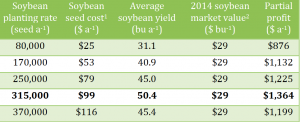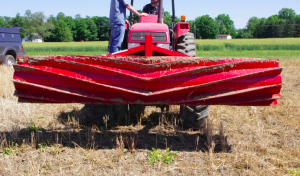On-farm and field trials in Pennsylvania, New York and Vermont show that cover cropping produces a number of financial benefits for farmers and wider environmental benefits for the community. Cover cropping increases soil organic matter (aka carbon) and microbial diversity while suppressing weeds and stabilizing soils, which can help farmers transition to organic methods as well as improve their agricultural practices cost-effectively. Fields with a cover crop have less erosion and less runoff, meaning nutrients stay in the soils, better not only for soil quality and crop yields, but also for preserving water quality and ecosystem health.
Fields with a cover crop experience less erosion and less runoff, meaning minerals stay in the soils, better not only for soil quality and crop yields, but also for preserving water quality, ecosystem, and climate health.
While the benefits of cover crops researched by Northeast Extension teams in crop, field, and soils are clear, the prescribed planting methods, timing, and seeding rates need careful consideration for successful seed establishment and sufficient cover growth depending on a number of factors including the site conditions, harvesting schedules, and farmer circumstances.
In Westford, Vermont, a cover crop of radish, rye, turnip, and white clover was successfully seeded after corn was harvested at Tony Pouliot’s farm under the guidance of UVM Extension agronomy expert Heather Darby.
Pouliot was pleased to see his soil protected, the most valuable asset of his farm as you can see in this Across the Fence video. Heather Darby and her team at UVM Northwest Soils and Crops provide invaluable advice to Vermont farmers in choosing appropriate cover crop seed mix, deciding on the methods and timing of planting whether before or after harvesting the cash crop, and many specifics related to the farm’s cropping systems, equipment available, location, topography and soil types.
A 2014 Cornell cover crop experiment with soybeans no-till planted into mulch from a winter cover crop at the Hudson Valley Farm Hub showed that a farm’s net profit was highest when seeding rates were double the recommended seeding rates of conventional soybean production. Five planting densities were compared and the crop population, weed suppression, and crop yields were measured. Matthew Ryan’s report on cover cropping strategies and his research projects are part of Cornell Sustainable Cropping Systems Lab.
UVM Extension’s Northwest Crops and Soils program produces guidance and tips on interseeding cover crops for Vermont farmers growing feedstock such as corn and soybeans. Advice concerns the timing of seeding, the level and depth of seeding, available labor and proper equipment, and altering other management practice (e.g. pesticide applications and tillage), which would harm cover crops.
Roller crimper turns cover crop into mulch for cash crop
The benefits of cover cropping reach beyond the farmer to the community and the climate.
Importantly, research has found that cover cropping may have no negative impact on corn yields and can sometimes have a positive yield effect. When over-wintered cover crops are “terminated” with a roller crimper in the spring, the mulch mat, which is formed suppresses weeds during the growing season for cash crops. In addition to increased profits to the farmer, the energy savings related to less diesel fuel used, less fertilizers and pesticides applied, result in less greenhouse gas emissions from the farm. The benefits of cover cropping reach beyond the farmer to the community and the climate.
« Dealing with weather at High Ledge Farm Farming like nature: healthy soils hold the key for productive farms and clean water »


